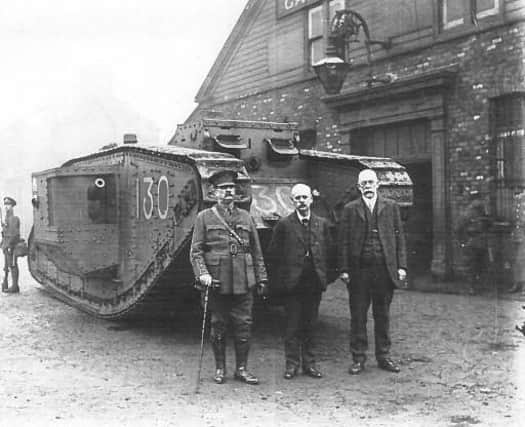Yes you could celebrate peace - but only if you washed your hands


Years earlier, the town had suffered 130 dead and 500 injured when German shells wreaked havoc in the Bombardment.
Now it was all over and people were safe. Or were they?
Spanish flu was on the way and it was just as deadly.
Researcher Gillian Hunt took a look back through the Northern Daily Mail archives.
Advertisement
Hide AdAdvertisement
Hide AdAt first, no one knew quite how to react when the Armistice was announced.
But a subdued Hartlepool town centre soon became awash with utter joy and emotion.
It had been expecting to turn out en masse for an event called Feed The Guns Week. (It was a campaign to raise money to buy guns for the war effort and Hartlepool was the best in the country).
But news that the war was over began to filter through and a “great excitement filled the town.”
Advertisement
Hide AdAdvertisement
Hide AdAt the same time, though, Hartlepool was suffering a new sickness.
It wasn’t alone in that suffering which was spreading across the world.
Gillian told us: “It is maybe understandable that the mood at first was subdued as the ’Pools had sustained not only the loss of men of the towns in the fighting but also the great loss of civilians life in the devastating bombardment almost four years earlier. Just as the war was ending, a new terror began.”
The autumn of 1918 saw the most deadly wave of the Spanish flu epidemic.
Advertisement
Hide AdAdvertisement
Hide AdThe Northern Daily Mail of the time report various cures on sale at Barkers’ chemist on York Road and advice on how to prevent infection such as washing with Lifebuoy soap before going to school.
Gillian asked: “How many people were unknowingly infected in the crowds celebrating the Armistice?”
The statistics for the Spanish flu pandemic were startling.
It is thought to have infected around 500million people worldwide and resulted in the deaths of somewhere between 50million to 100million people.
Advertisement
Hide AdAdvertisement
Hide AdAnd this was in an era when life expectancy was already limited.
Still, when they could, the people of Hartlepool found ways of celebrating.
Most of the town’s factories had a holiday on the day of the Armistice and it was not long before the streets were crowded.
By 11 o’clock, there were big crowds and they were all keen for the news they had waited longingly for to be confirmed.
Advertisement
Hide AdAdvertisement
Hide AdIt wasn’t long before it arrived, courtesy of the Northern Daily Mail.
The “Mail” boys rushed out with the special edition containing news that the armistice had been signed.
“The first group of newsboys were speedily surrounded by an eager crowd of people and the lads found it impossible to move. Movement, however, was necessary on their part for they were speedily relieved of their papers,” said the Northern Daily Mail at the time.
“Quickly the news was circulated and it was received at first in a somewhat subdued manner, the thanksgiving being too heartfelt to at once find outward and boisterous expression.
Advertisement
Hide AdAdvertisement
Hide Ad“Tears and smiles indeed seemed to be fighting for the mastery. The smiles won, however, and brilliant sunshine was shed upon thousands of wondrously happy faces across the town.”
Soon, Hartlepool was buzzing with joy.
“Presently, flags and streamers were run up from all the principal buildings and the scene became as lively and festive in appearance as one could desire,” said the Mail.
“We are a stolid people” someone in the crowd had just remarked but the most stolid are moved sometimes and the people of the ‘Pools after four and a half years’ strain and agonised tension could not restrain their feeling of relief for long.
“The clash of joyous bells from Christ Church tower, the cheery music by the military bands and the buzzers at the works all helped the people fling off any remaining feelings of gloom and unite in general rejoicing.”
Advertisement
Hide AdAdvertisement
Hide AdGillian explained: “ The week had been planned as a “Feed the Guns” week opening on November 12 to raise money for the war effort so there were guns on display, children marching and military bands in town.
“Once peace was declared, this became “Thank the Guns”.
The end of the war was such a momentous piece of news that the commemorations went on for days.
“That evening and in the days which followed, there were services of thanksgiving in the churches, concerts every night and free screenings at the picture houses,” said Gillian.
“The bands of different regiments played tunes galore. And lots of them were keen to do it for an appreciative public.”
Advertisement
Hide AdAdvertisement
Hide AdThe 3rd Yorks, 4th West Yorks, 3rd Battalion of the Cheshires all turned out and they were all playing popular tunes.
War might have been over but life wasn’t ready to go back to normal just yet.
Lighting restrictions were lifted but not in shop windows or advertising. The town still had to save coal.
Fireworks were available for organised displays but not for purchase by the general public.
Advertisement
Hide AdAdvertisement
Hide AdAnd as a modicum of normality returned, church bells were rung again and clocks could finally chime at night. They had stopped during the war for fear of attracting Zeppelins and bombers.
Life was returning to normal, albeit rather slowly.